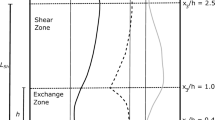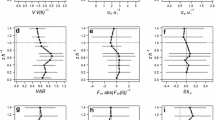Abstract
The intermittent structure of turbulence within the canopy sublayer (CSL) is sensitive to the presence of foliage and to the atmospheric stability regime. How much of this intermittency originates from amplitude variability or clustering properties remains a vexing research problem for CSL flows. Using a five-level set of measurements collected within a dense hardwood canopy, the clustering properties of CSL turbulence and their dependence on atmospheric stability are explored using the telegraphic approximation (TA). The binary structure of the TA removes any amplitude variability from turbulent excursions but retains their zero-crossing behaviour, and thereby isolating the role of clustering in intermittency. A relationship between the spectral exponents of the actual and the TA series is derived across a wide range of atmospheric stability regimes and for several flow variables. This relationship is shown to be consistent with a relationship derived for long-memory and monofractal processes such as fractional Brownian motion (fBm). Moreover, it is demonstrated that for the longitudinal and vertical velocity components, the vegetation does not appreciably alter fine-scale clustering but atmospheric stability does. Stable atmospheric stability conditions is characterized by more fine scale clustering when compared to other atmospheric stability regimes. For scalars, fine-scale clustering above the canopy is similar to its velocity counterpart but is significantly increased inside the canopy, especially under stable stratification. Using simplified scaling analysis, it is demonstrated that clustering is much more connected to space than to time within the CSL. When comparing intermittency for flow variables and their TA series, it is shown that for velocity, amplitude variations modulate intermittency for all stability regimes. However, amplitude variations play only a minor role in scalar intermittency. Within the crown region of the canopy, a ‘double regime’ emerges in the inter-pulse duration probability distributions not observed in classical turbulence studies away from boundaries. The double regime is characterized by a power-law distribution for shorter inter-pulse periods and a log-normal distribution for large inter-pulse periods. The co-existence of these two regimes is shown to be consistent with near-field/far-field scaling arguments. In the near-field, short inter-pulse periods are controlled by the source strength, while in the far-field long inter-pulse periods are less affected by the precise source strength details and more affected by the transport properties of the background turbulence.
Similar content being viewed by others
References
Barnett JT, Kedem B (1991) Zero-crossing rates of functions of Gaussian processes. IEEE Trans Inf Theory 37(4): 1188–1194. doi:10.1109/18.86972
Bermejo-Moreno I, Pullin DI (2008) On the non-local geometry of turbulence. J Fluid Mech 603: 101–135. doi:10.1017/S002211200800092X
Bershadskii A, Niemela JJ, Praskovsky A, Sreenivasan KR (2004) “Clusterization” and intermittency of temperature fluctuations in turbulent convection. Phys Rev E Stat Nonlin Soft Matter Phys 69(5): 056314. doi:10.1103/PhysRevE.69.056314
Calzavarini E, Van den Berg TH, Toschi F, Lohse D (2008) Quantifying micro-bubble clustering in turbulent flow from single-point measurements. Phys Fluids 20(4): 040702. doi:10.1063/1.2911036
Cava D, Katul GG (2008) Spectral short-circuiting and wake production within the canopy trunk space of an alpine hardwood forest. Boundary-Layer Meteorol 126(3): 415–431. doi:10.1007/s10546-007-9246-x
Cava D, Giostra U, Siqueira M, Katul G (2004) Organized motion and radiative perturbations in the nocturnal canopy sublayer above an even-aged pine forest. Boundary-Layer Meteorol 112(1): 129–157. doi:10.1023/B:BOUN.0000020160.28184.a0
Cava D, Katul GG, Scrimieri A, Poggi D, Cescatti A, Giostra U (2006) Buoyancy and the sensible heat flux budget within dense canopies. Boundary-Layer Meteorol 118(1): 217–240. doi:10.1007/s10546-005-4736-1
Cava D, Katul GG, Sempreviva AM, Giostra U, Scrimieri A (2008) On the anomalous behavior of scalar flux-variance similarity functions within the canopy sub-layer of a dense Alpine forest. Boundary-Layer Meteorol 128: 33–57. doi:10.1007/s10546-008-9276-z
Chambers AJ, Antonia RA (1984) Atmospheric estimates of power-law exponent-mu and exponent-mu-theta. Boundary-Layer Meteorol 28(3–4): 343–352. doi:10.1007/BF00121313
Coeurjolly JF (2000) Simulation and identification of the fractional Brownian motion: a bibliographical and comparative study. J Stat Softw 5: 1–53
Detto M, Katul G (2007) Simplified expressions for adjusting higher-order turbulent statistics obtained from open path gas analyzers. Boundary-Layer Meteorol 122(1): 205–216. doi:10.1007/s10546-006-9105-1
Finnigan J (2000) Turbulence in plant canopies. Annu Rev Fluid Mech 32: 519–571. doi:10.1146/annurev.fluid.32.1.519
Jensen HJ (1998) Self-organised criticality. Cambridge University Press, UK, p 151
Jensen JH, Kristensen K, Fogedby HC (1989) 1/f noise, distribution of lifetimes, and a pile of sand. Phys Rev B 40(10): 7425–7427. doi:10.1103/PhysRevB.40.7425
Katul GG, Parlange MB, Chu CR (1994) Intermittency, local isotropy, and non-gaussian statistcs in atmospheric surface-layer turbulence. Phys Fluids 6(7): 2480–2492. doi:10.1063/1.868196
Katul GG, Hsieh CI, Sigmon J (1997) Energy-inertial scale interactions for velocity and temperature in the unstable atmospheric surface layer. Boundary-Layer Meteorol 82(1): 49–80. doi:10.1023/A:1000178707511
Katul GG, Angelini C, De Canditiis D, Amato U, Vidakovic B, Albertson JD (2003) Are the effects of large scale flow conditions really lost through the turbulent cascade?. Geophys Res Lett 30: 1164. doi:10.1029/2002GL015284
Katul GG, Porporato A, Cava D, Siqueira MB (2006) An analysis of intermittency, scaling, and surface renewal in atmospheric surface layer turbulence. Physica D 215: 117–126. doi:10.1016/j.physd.2006.02.004
Kuznetsov VR, Praskovsky AA, Sabelnikov VA (1992) Fine-scale turbulence structure of intermittent shear flows. J Fluid Mech 243: 595–622. doi:10.1017/S0022112092002842
Mahrt L (1989) Intermittency of atmospheric-turbulence. J Atmos Sci 46(1): 79–95. doi:10.1175/1520-0469(1989)046<0079:IOAT>2.0.CO;2
Mahrt L, Sun J, Blumen W, Delany T, Oncley S (1998) Nocturnal boundary-layer regimes. Boundary-Layer Meteorol 88(2): 255–278. doi:10.1023/A:1001171313493
Marcolla B, Pitacco A, Cescatti A (2003) Canopy architecture and turbulence structure in a coniferous forest. Boundary-Layer Meteorol 108(1): 39–59. doi:10.1023/A:1023027709805
Meneveau C (1991) Analysis of turbulence in the orthonormal wavelet representation. J Fluid Mech 232: 469–520. doi:10.1017/S0022112091003786
Moisy F, Jimenez J (2004) Geometry and clustering of intense structures in isotropic turbulence. J Fluid Mech 513: 111–133. doi:10.1017/S0022112004009802
Moisy F, Jimenez J (2006) Clustering of intense structures in isotropic turbulence: numerical and experimental evidence. Paper presented at IUTAM symposium on elementary vortices and coherent structures: significance in turbulence dynamics, pp 3–12. doi:10.1007/1-4020-4181-0_1
Monin AS, Yaglom AM (1971) Statistical fluid mechanics, vol. 1. MIT Press, Cambridge, p 769
Obukhov AM (1962) Some specific features of atmospheric turbulence. J Fluid Mech 13: 77–81. doi:10.1017/S0022112062000506
Poggi D, Katul GG (2006) Two-dimensional scalar spectra in the deeper layers of a dense and uniform model canopy. Boundary-Layer Meteorol 121: 267–281. doi:10.1007/s10546-006-9075-3
Shi B, Vidakovic B, Katul GG, Albertson JD (2005) Assessing the effects of atmospheric stability on the fine structure of surface layer turbulence using local and global multiscale approaches. Phys Fluids 17(5): 055104. doi:10.1063/1.1897008
Sreenivasan KR (1990) Fluid-dynamics—turbulence and the tube. Nature 344(6263): 192–193. doi:10.1038/344192a0
Sreenivasan KR (1991) Fractals and multi-fractals in fluid turbulence. Annu Rev Fluid Mech 23: 539–600. doi:10.1146/annurev.fl.23.010191.002543
Sreenivasan KR (1999) Fluid turbulence. Rev Mod Phys 71(2): S383–S395. doi:10.1103/RevModPhys.71.S383
Sreenivasan KR, Antonia RA (1997) The phenomenology of small-scale turbulence. Annu Rev Fluid Mech 29: 435–472. doi:10.1146/annurev.fluid.29.1.435
Sreenivasan KR, Bershadskii A (2006) Clustering properties in turbulent signals. J Stat Phys 125(5–6): 1145–1157. doi:10.1007/s10955-006-9112-0
van Dop H, Verver G (2001) Counter-gradient transport revisited. J Atmos Sci 58(15): 2240–2247. doi:10.1175/1520-0469(2001)058<2240:CTR>2.0.CO;2
Vassilicos JC (2006) The physics of turbulent mixing and clustering. In: Direct and large-eddy simulation VI, Springer, Netherlands, pp 69–74.
Warhaft Z (2000) Passive scalars in turbulent flows. Annu Rev Fluid Mech 32: 203–240. doi:10.1146/annurev.fluid.32.1.203
Webb EK, Pearman GI, Leuning R (1980) Correction of flux measurements for density effects due to heat and water-vapor transfer. Q J R Meteorol Soc 106(447): 85–100. doi:10.1002/qj.49710644707
Author information
Authors and Affiliations
Corresponding author
Rights and permissions
About this article
Cite this article
Cava, D., Katul, G.G. The Effects of Thermal Stratification on Clustering Properties of Canopy Turbulence. Boundary-Layer Meteorol 130, 307–325 (2009). https://doi.org/10.1007/s10546-008-9342-6
Received:
Accepted:
Published:
Issue Date:
DOI: https://doi.org/10.1007/s10546-008-9342-6




